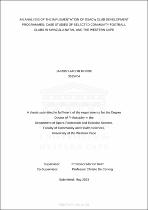| dc.description.abstract | Scholars such as Seippel and Belbo (2021), Robertson, Eime and Westerbeek (2018) and Sotiriadou and Wicker (2013) regard community sports clubs as a panacea for the challenges associated with building social capital, social engagement and community cohesion. In the South African context, the Club Development Programme (CDP) is a key initiative of the Department of Sports, Arts and Culture (DSAC) which was introduced in 2006 to promote community sport development. However, there is scant academic research that has examined the design and implementation of this programme with a view to understanding its challenges and/or success factors. Premised on a management theoretical framework, the focus of which is primarily on the design and implementation of community sport development programmes, this qualitative study examined the design and implementation of the CDP in South Africa through the lenses of two purposively selected provinces: the Western Cape (WC) and KwaZulu-Natal (KZN). These provinces were targeted on the basis that they were reported to have a better system to implement the CDP (Club development coordinators, 2017). The findings of this study revealed that the CDP has been operating without any existing substantive model to demonstrate how the programme ought to be designed and implemented effectively in South African communities. Therefore, priorities to be addressed for the effective implementation of the CDP in the South African setting include that: platforms to be prioritised to strengthen relationships with key stakeholders to give valuable input; good systemic governance at club and federation level need to be promoted; mechanisms to be introduced to prevent the abuse of power within the CDP; the CDP management needs to be diligent in recruiting new personnel to the programme; all of the programme coordinators must undergo rigorous training to enable them to acquire knowledge and skills to implement, monitor and evaluate the programme effectively; a succession plan must be prioritised for the CDP administrators; quality equipment and clothing be distributed equally to clubs that have not yet received them; and programme coordinators must frequently invite community clubs to the CDP planning sessions. This study contributes to the limited and growing academic literature on the design and effective implementation of community sports club programmes with reference to South Africa and Africa at large. | en_US |

